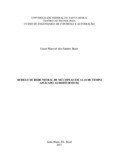| dc.contributor.advisor | Guerra, Rodrigo da Silva | |
| dc.creator | Stein, Gean Marciel dos Santos | |
| dc.date.accessioned | 2017-08-01T17:17:58Z | |
| dc.date.available | 2017-08-01T17:17:58Z | |
| dc.date.issued | 2017-02-22 | |
| dc.date.submitted | 2017 | |
| dc.identifier.uri | http://repositorio.ufsm.br/handle/1/11290 | |
| dc.description | Trabalho de conclusão de curso (graduação) - Universidade Federal de Santa Maria, Centro de Tecnologia, Curso de Engenharia de Controle e Automação, RS, 2017. | por |
| dc.description.abstract | The idea for the implementation and application of the Multiple Timescale Recurrent Network (MTRNN) model started with experiments based on machine learning (Peniak et al., 2011; Nobuta et al., 2011). In which a humanoid robot learns complex activities through interaction with humans. The MTRNN model (Yamashita and Tani, 2008) is distinguished by having two main types of units, the fast neurons and the slow neurons. This characteristic of the network makes it able to encode and reproduce in detail dynamic phenomena in fast neurons and at the same time represent these phenomena in a higher degree of abstraction in the slower neurons, bringing an idea analogous to the intentionality of the actions observed in humans and in others Animals. The main goal of this work is the application of the MTRNN model in the Dimitri robot, recently developed at the UFSM Technology Center. The neural network was implemented in Python, and its implementation started in a previous work. The network training uses the Backpropagation Through Time (BPTT) learning algorithm optimized by Nesterov's accelerated gradient method. The data used for the training of the network refer to the position of the servo motors when being manipulated by a tutor, who will perform cyclical movements. Experiments were carried out to test the network and its characteristics. The implemented network was able to learn three different movement patterns, but was unable to operate in closed loop due to sensitivity to disturbances, so the network is not ready to be applied directly to the Dimitri robot. | eng |
| dc.language | por | por |
| dc.publisher | Universidade Federal de Santa Maria | por |
| dc.rights | Acesso Aberto | por |
| dc.subject | Neural network | eng |
| dc.subject | Machine learning | eng |
| dc.subject | Aprendizado de máquina | por |
| dc.subject | Rede neural | por |
| dc.subject | MTRNN | por |
| dc.subject | Dimitri | por |
| dc.title | Modelo de rede neural de múltiplas escalas de tempo aplicado ao robô Dimitri | por |
| dc.title.alternative | Multiple timescale recurrent network model applied on the Dimitri robot | eng |
| dc.type | Trabalho de Conclusão de Curso de Graduação | por |
| dc.degree.local | Santa Maria, RS, Brasil | por |
| dc.degree.graduation | Engenharia de Controle e Automação | por |
| dc.description.resumo | A proposta para a implementação e aplicação do modelo de rede neural recorrente de múltiplas escalas de tempo (MTRNN – Multiple Timescale Recurrent Neural Network) surgiu de experimentos na área de aprendizagem de máquina (Peniak et al. 2011; Nobuta et al. 2011), nos quais um robô humanoide aprende atividades complexas através da interação com humanos. O modelo MTRNN (Yamashita e Tani, 2008) se distingue por possuir dois tipos de unidades principais, os neurônios rápidos e os neurônios lentos. Essa característica da rede a torna capaz de codificar e reproduzir em detalhe fenômenos dinâmicos nos neurônios rápidos e ao mesmo tempo representar estes fenômenos em um grau de abstração mais alto nos neurônios mais lentos, trazendo ideia análoga à intencionalidade das ações observadas em humanos e em outros animais. O objetivo geral do trabalho é a aplicação do modelo MTRNN no robô Dimitri, recentemente desenvolvido no Centro de Tecnologia da UFSM. A rede neural foi implementada em Python, tendo sua implementação iniciada em um trabalho anterior. O treinamento da rede utiliza o algoritmo de aprendizagem Backpropagation Through Time (BPTT) otimizado pelo método de gradiente acelerado de Nesterov. Os dados usados para o treinamento da rede referem-se à posição dos servo-motores ao serem manipulados por um tutor, o qual irá executar movimentos cíclicos. Foram realizados experimentos a fim de testar a rede e suas características. A rede implementada foi capaz de aprender três padrões de movimentos diferentes, mas foi incapaz de operar em malha fechada devido à sensibilidade a distúrbios, sendo assim a rede não está pronta para ser aplicada diretamente no robô Dimitri. | por |
| dc.publisher.country | Brasil | por |
| dc.publisher.initials | UFSM | por |
| dc.subject.cnpq | CNPQ::ENGENHARIAS | por |
| dc.publisher.unidade | Centro de Tecnologia | por |


